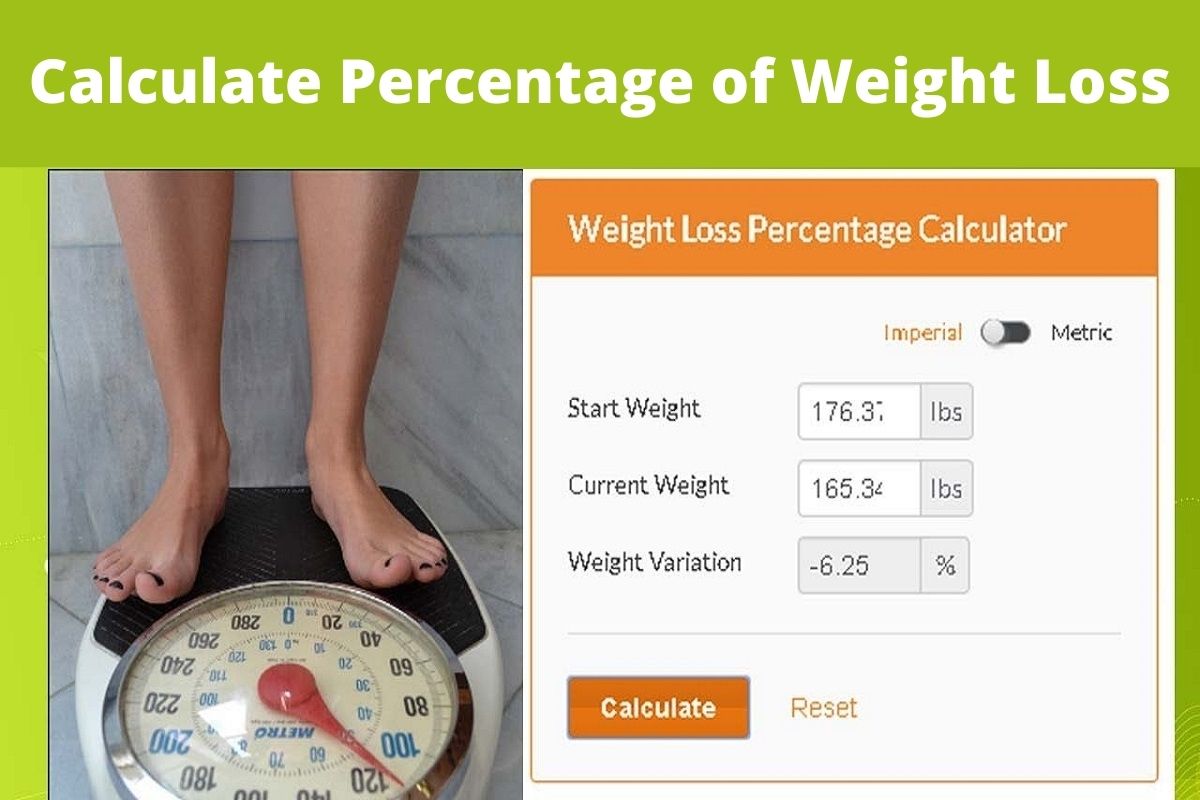How to Calculate Percentage of Weight Loss?

When you are trying to lose weight, it is important to track your progress. One way to do this is to calculate your percentage of weight loss. But how to calculate the percentage of weight loss? This can be tricky, but with a little bit of know-how, you can do it easily. This will give you a good idea of how well you are doing and how much progress you have made. With these tips and tricks, you’ll be able to do it like a pro!
In this article, we’ll discuss the different methods for calculating weight loss percentage and which one is best for you. Plus, we’ll provide some helpful tips on staying on track with your weight loss goals. So read on to learn more!
How to Calculate Percentage of Weight Loss?
Have you been trying to lose weight and hit a plateau? You may be wondering how much weight you’ve actually lost. Luckily, there are a few ways to calculate the percentage of weight loss so you can stay on track. We’ll share tips and tricks on how to accurately calculate your percentage of weight loss. So, whether you’re just starting out or have hit a snag in your progress, keep reading for helpful advice!
Percentage weight loss is a calculation of how much weight you’ve lost relative to your starting point. To calculate it, simply take your current weight and divide it by your starting weight. For example, if you started at 200 pounds and now weigh 150 pounds, you would take 150/200 to get 75%. This means that you’ve lost 25% of your body weight.
If you want to get really accurate, you can also have your body fat percentage professionally measured using DEXA (dual-energy X-ray absorptiometry) or hydrostatic weighing. However, these methods are usually only available at research facilities or through specialty fitness coaches.
Another way is to use a body fat percentage calculator. There are many different ways to calculate body fat, but most fitness professionals use the skinfold method. To do this, you’ll need to measure three different areas of your body with calipers. Once you have your measurements, you can plug them into a calculator like this one from the American Council on Exercise.
Another way to measure weight loss is by how your clothes fit. This method isn’t as exact as using a scale or measuring body fat, but it can give you a good idea of how much weight you’ve lost. Notice how your waistline, hips, and thighs feel in your clothes. If you’re losing weight, you’ll probably notice that your clothes are looser than they used to be. This is especially true if you’ve lost a significant amount of weight.
Read More: How to Drink Kombucha for Weight Loss?
Things to Consider
There are a few things to keep in mind when using this method to track your progress.
- First, remember that muscle weighs more than fat. So, if you’ve been working out and building muscle mass, you may not see as large of a percentage drop as someone who has only been dieting.
- Second, water weight can also play a role in the numbers. If you’ve recently started a new diet or workout routine, you may see a higher percentage of weight loss at first due to water weight.
Keep track of your progress over time to get the most accurate picture of your success. And don’t focus too much on the numbers. The most important thing is how you feel and whether or not you’re seeing results in how your clothes fit, your energy levels, etc. Use the percentage as a tool to help you measure your progress, but don’t get too caught up in it.
Happy calculating! And good luck on your weight loss journey!
What Factors Can Affect Your Percentage Weight Loss Calculation Results (E.G., Muscle Mass, Water Retention)?
The factors that can affect your percentage weight loss calculation results are muscle mass and water retention. If you have a lot of muscle mass, you may not see as great of results on the scale because muscle weighs more than fat. And if you’re retaining water, that can also lead to a higher number on the scale even if you’re actually losing body fat.
So How Do You Account for These Factors?
Well, one way is to take your measurements (waist, hips, thighs, arms, etc.) in addition to tracking your weight. This way you can see how your body is changing even if the numbers on the scale aren’t moving as much as you’d like.
Ways to Calculate Weight Loss as a Percentage
There are many online calculators that can help you determine your body weight percentage. All you need to do is enter your current weight and height, and the calculator will do the rest.
1. Use an Online Bodyweight Percentage Calculator
Calculate your bodyweight percentage (Body Weight Percentages)
Just remember that these calculators are only estimates, and they may not be 100% accurate. If you want a more precise estimate, you can use the following formula:
Percentage of weight loss= [(initial weight – final weight)/initial weight] x 100%. For example, if someone weighed 200 pounds (90.72 kg) at the start of their diet
2. Use This Simple Weight Loss Percentage Equation
This is a simple weight loss percentage equation:
[(current weight – target weight)/target weight] x 100%.
For example, if you currently weigh 150 pounds (68.04 kg) and your goal is to reach 130 pounds (59.09 kg), your percentage of weight loss would be:
[(150-130)/130] x 100% = 15%.
This equation is only an estimate, and it doesn’t take into account how much muscle mass you have or how active you are.
3. Calculate Weight Loss as a Percentage in a Spreadsheet
Recording your weight loss over time in a spreadsheet is an excellent way to track your progress. You can calculate your weight loss percentage by taking your current weight, subtracting your starting weight, and dividing that number by your starting weight. Multiply that number by 100 to get your weight loss as a percentage.
For example, if you started at 200 pounds (90.718 kilograms) and you currently weigh 190 pounds (86.183 kilograms), then you would do the following calculation:
(190 – 200) / 200 = -0.05
-0.05 x 100 = -five percent
This means that you have lost five percent of your body weight since you started tracking!
How to Track Your Progress Over Time and Ensure Accurate Calculations?
It’s not enough to simply calculate your percentage of weight loss once. In order to properly track your progress, you need to be calculating it on a regular basis. This will help you see how well you’re doing and whether or not you need to make any adjustments to your diet or exercise routine.
To ensure that your calculations are accurate, it’s important to use the same method each time. You can either weigh yourself regularly or take measurements with a tape measure. If you choose the latter option, be sure to measure the same areas of your body each time (waist, hips, thighs, etc.).
Once you have your starting measurements, it’s time to start tracking your progress! Make sure to write down your measurements.
Tips for Staying Motivated During Your Weight Loss Journey
Losing weight can be a difficult and challenging process. There are many ups and downs, and it can be easy to get discouraged. However, staying motivated is key to achieving your weight loss goals. Here are a few tips to help you stay on track:
✔ Find A Support Group:
Whether it’s online or in-person, having people who are going through the same thing as you can be incredibly helpful. You can share tips, vent about setbacks, and celebrate successes together.
✔ Set Small Goals:
Rather than focusing on the end goal, set smaller goals that you can achieve along the way. This will help you stay motivated and see progress even when the scale isn’t moving
✔ Find an Activity You Enjoy:
Choose an exercise routine that you actually enjoy so that it doesn’t feel like a chore.
✔ Reward Yourself:
Allow yourself to indulge in a healthy treat or activity once you reach your goal to help maintain your motivation.
These are just a few tips to help you stay motivated during your weight loss journey. Find what works for you and stick with it! The most important thing is to never give up on yourself.
FAQS About Percentage Weight Loss Calculations
These are some FAQs about percentage weight loss calculations
Q1. How Often Should I Weigh Myself?
Weigh yourself at the same time every day for the most accurate results.
Q2. What If I Don’t Have a Scale?
There are other ways to track your progress besides using a scale. Try measuring your waistline, hips, and thighs with a tape measure. You can also take progress photos to see the changes in your body over time.
Q3. What Is the Difference Between Losing Fat and Losing Weight?
Losing fat refers to losing the actual tissue from your body while losing weight includes both
Q4. What Is a Healthy Rate of Weight Loss?
Most health experts recommend aiming for a slow and steady weight loss of no more than two pounds per week. Losing weight at a slower pace gives your body time to adjust and reduces the likelihood that you’ll regain the weight later on.
Q4. How Do I Calculate How Much Water Weight I’ve Lost?
To calculate your percentage of water weight loss, simply subtract your current weight from your starting weight. Then, divide that number by your starting weight and multiply by 100. For example, if you started out at 200 pounds and you now weigh 190 pounds, you would have lost five percent of your body weight in water weight.
Final Verdict!
Well, there you have it! Do you now know how to calculate the percentage of weight loss? Remember, though, that weight loss is not always about the numbers. It’s also important to focus on how you feel and how your clothes fit. As long as you’re making progress in those areas, you’re doing great! If you’re trying to lose weight, it’s important to set a realistic goal. A good rule of thumb is to aim for a loss of one to two pounds per week. This may not seem like much, but it adds up over time and helps to keep the weight loss off.
Read More: How Rapid is Weight Loss with Farxiga?





